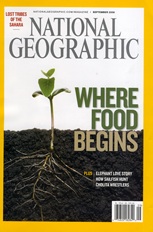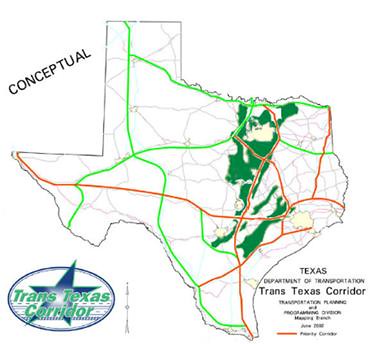Cox addresses speed limits, other considerations at TTC meetingBy ANDY HOGUE,
Gainesville Daily Register
Though stalled in the water for now, discussion on the Trans-Texas Corridor 35 project continues, according to a report from Cooke County’s representative on the project.
Sheila Cox, who was a vocal opponent to the multi-modal toll road project when first presented to the public, was appointed to a regional corridor advisory committee last year. Cox submitted a summary of the advisory committee’s actions from July 23 in Austin, in which she said the project is far from being “dead.”“... The TTC is still very much alive and continues as a threat to all Texans,” she said in her summary, which appeared in its entirety in the July 25 Register.The next meeting of the advisory committee is from 10 a.m. to 2 p.m. Aug. 21, a Thursday, in Austin (exact location TBA — most likely at the Greer Building on south side of the Capitol on 11th Street). The public is allowed to attend, Cox said, but are not allowed to speak or participate in the discussion.She said she would like to see a good “delegation” from Cooke County at the Aug. 21 meeting.
“We’re designated at the convergence point for the Trans-Texas Corridor system, so we have much to lose by not being involved and much to gain if we are,” Cox said.
Chairs for guests are situated around the delegation room, while committee members are seated around tables, she noted, noting there is ample room.
Cox said there are usually five to 10 people watching the meetings. She noted Jan Johnson of Cooke County had attended the last two Austin meetings.
Though Cox’s summary of the July meeting had some sharp comments of her fellow committee members, she said feedback has been positive so far.
“I’ve had lots of people contact me, telling me they appreciate me for bringing them up to speed on what’s happening,” she said in an interview this morning.
According to Cox’s summary, the meeting agenda included presentations by two corporations who are members in NASCO (North American Super Corridor Coalition), Cox said. Those presentations were by Scott Braden, President of the Southwest and High Plains Divisions of McLane Trucking Company, and by Russell Laughlin, Vice President of Alliance Texas which is headed by Ross Perot. Both of these presentations included emphasis on the need for the NAFTA Super Highway as a trade route from Mexico through the United States and into Canada.
Also emphasized in these presentations was the role of the Trans-Texas Corridor in the implementation of an international express highway system.
In the question and answer wrap-up of Braden’s presentation, which had highlighted the requirements of major trucking firms, Cox said she asked what was the most cost-efficient miles-per-hour speed for trucks to travel. Braden replied, according to Cox, that 62 mph had been proven to be the most cost-efficient speed and at that speed even the pollution levels were less than at higher speeds.
Braden later indicated that his company’s truckers are ordered to not exceed 62 mph and he described his company’s electronic monitoring system that allows each of their trucks to be monitored during their entire routes.
Cox said she addressed the concern that the TTC corridors are proposed to have 80 mph speed limits for trucks and based on his comments that it would appear that the widespread non-attainment pollution control areas in Texas would only worsen with many trucks from other companies traveling at much higher speeds than 62 mph.Laughlin commented on the TTC’s plans for Alliance, located north of Fort Worth and south of Denton, which contains Alliance Airport.“I've given you the plan and the development,” Laughlin said, according to Cox’s notes. “Now you have the plan and the development, so get with the plan or get out of the way.”
Cox said she replied by emphasizing cooperation.
“I asked Mr. Laughlin where is the interaction from the citizens in his closing comment that stated ‘so get with the plan or get out of the way.’ He was speechless and did not respond to my question and at that point the meeting facilitator moved the discussion to the next meeting agenda item,” Cox said.The committee had several other points of “lively discussion,” according to Cox.One of those lively discussions dealt with a comment made by committee member, Lana Wolf, mayor of Arlington.Wolf, according to Cox, said “the TTC needed to get moving faster from the talking stage to the doing stage ... the only opponents to the TTC are coming from those farm people.”Cox said the opposition to the TTC comes from both major political parties in Texas and not just those in rural, agricultural settings. Cox said she quoted the state Republican and Democratic parties’ platform planks against TTC and eminent domain abuse from various years.“Wolf seemed shocked by the comments in the Republican and Democratic Platforms and she said that ‘it was just words on paper and no elected official would agree to a platform like that and they would leave the parties to become independents,’” Cox said. “I mentioned that would be an option for them but that the Independent Texans Party and the Constitution Party of Texas had similar platforms also strongly stating opposition to the TTC, abusive eminent domain and the Constitutional infringements of private property ownership.”Cox said the comments by Wolf, Laughlin and Braden are cause for concern.“There is a disregard that is prevailing — not just in some of the members of the committee, but it is prevalent in so many areas of government,” she said this morning.For information on attending the advisory committee meeting, contact Cox at 1(940)727-2187 or at billsheila@swmail.net
© 2008, The Gainesville Daily Register:
www.gainesvilleregister.com
 The September issue of National Geographic has an interesting article, “Our Good Earth,” on the soils of the world and the dangers to them.
The September issue of National Geographic has an interesting article, “Our Good Earth,” on the soils of the world and the dangers to them.





